Restorative Dentistry in Tempe, AZ | Wood Family Dentistry

During your first dental examination with x-rays, you will be given the opportunity to discuss your dental health and goals. What is important to you, is priority for us. You will be presented with options to meet your dental goals. We offer many different services. But, you will be invited to join the decision-making process of what dental treatment will work best for you. In partnership with YOUR dentist, you will have a healthy smile and know you were a part of the process. Leaving the dental office feeling confident and informed of your dental plan is our goal.
Restore the Function and Strength of Your Teeth
Do you need to replace a missing tooth or repair a damaged one? Some of the most common dental problems that Americans face are decay, cavities, and missing teeth. When these issues are left untreated, they can result in serious headaches down the road, which is where preventive treatments such as dental crowns come in. Our goal is to give our patients the treatment and knowledge they need to maintain a healthy and happy smile for years to come.
Dental crowns are an important cornerstone of restorative dentistry, being designed to fit over individual teeth and restore their function, look, and shape seamlessly. There are several reasons dentists recommend having a crown created and placed, including:
- Severe dental decay
- An injury to a tooth
- A generally weakened tooth
- Cosmetic concerns, like misshapen enamel
- The finishing touch for root canal therapy
- The finishing touch for dental implants
Crowns can also be used in conjunction with dental bridges, which are designed to replace one or more missing teeth in a row. This restorative solution can be a lifesaver, filling in empty gaps in your smile and restoring much-needed facial structure and biting strength. The dental crowns fall on either side, attaching to nearby healthy teeth as “anchors” that keep the bridge firmly in place for a more secure fit overall. Removable bridges, also known as partials, are available as well.
What are Dental Crowns?

Dental crowns are custom-made caps that we place on top of a tooth to help restore its function and strength as well as protect it from additional damage. Typically, patients will receive crowns after root canal therapy to help make their tooth stronger and prevent harmful oral bacteria from wreaking more havoc on it. They’re cemented into place and fully cover the visible portion that is above the gum line.
What are Dental Bridges?

Dental bridges close gaps between one or multiple missing teeth. They use two crowns on either side of the gap to hold the replacement tooth in place. The replacements are typically made from porcelain or a combination of materials.
What are the Benefits of Both?
Dental crowns offer great benefits to your oral health and can save you time, money, and future oral health problems down the road. Some other benefits of crowns include:
- Strengthening your teeth so you can eat and chew without causing damage.
- Restoring your damaged tooth to its natural shape and size.
- Protecting a tooth from further damage.
- Enhancing the appearance of your tooth.

If you’re looking to replace a missing tooth, dental bridges are probably the best option for you. Leaving gaps in your smile can cause your existing teeth to shift in order to fill the space, creating more nooks and crannies for plaque and tartar to hide in. Dental bridges can benefit you by:
- Restoring your smile and self-confidence.
- Allows you to chew and speak properly.
- Prevents drifting teeth.
- Evenly distributes the force of your bite.
Do I Need a Crown or Bridge?
To find out if you need a dental crown or bridge, it’s best to schedule a consultation. We can help you figure out what the best restorative solution for your smile would be. Typically, if you’re suffering from severe dental decay that can’t be treated with a simple filling, you’ll need a crown to restore and protect your tooth. However, if you’re looking to replace a missing tooth so you can more easily complete daily functions like eating and chewing, a dental bridge is most likely the right choice for you.

Maintaining your oral health is easier than you think. When you visit Wood Family Dentistry, you’ll feel in great hands. We’ll restore your smile and make sure you receive necessary treatments so you can have a happy and healthy smile for years to come.
Your Invisible Filling Solution

Years ago, when you had a cavity filled, you had to deal with a big silvery blob on your tooth. Although very durable, these unsightly amalgam fillings also potentially cause your teeth to fracture more easily over time. Thankfully, the days when amalgam fillings were the best available option are over. Now, we use more aesthetically friendly tooth-colored fillings, called composite fillings, to restore your tooth after decay or damage.
If you’ve ever had fillings placed decades ago, you’re probably aware of the silver color they have. Not only is the material used in silver fillings less attractive in your smile, but there’s evidence that suggests that they’re more likely to fracture teeth further after long-term use. Typically, silver fillings require removing small amounts of enamel in order to fit inside damaged teeth. However, these fillings often act as a wedge in teeth, separating them apart further, rather than offering sufficient protection.
That’s where composite fillings come in. By utilizing composite resin instead of amalgam, dentists can replace your silver fillings and more effectively fill cracks in teeth. Not only does this material work to blend in more effectively with teeth, but it also creates a better seal against bacteria. Because of its pliable material, it also distributes force more evenly than silver fillings, so you don’t need to sacrifice quality for aesthetic reasons.
What are composite fillings made of?

Unlike amalgam fillings, which consist of mercury, silver, tin, and copper, tooth-colored fillings are completely metal free. They are made of composite resin, a combination of plastic material with fine ceramic particles that can be shaded to match the color of your tooth. This flexible mixture is biocompatible, which, simply put, means that these fillings won’t negatively impact living tissue. Composite resin also bonds well to the tooth’s natural structure, unlike amalgam, which requires removing extra enamel so that it stays in place better.
What are the benefits of composite fillings?
Because of their many beneficial properties, composite fillings have several advantages over their amalgam counterparts, including the following:
- Blend in with your natural tooth. No one will be able to tell that you ever had a cavity there.
- Reinforce the tooth’s structure. Although amalgam lasts longer, over time, it can act more like a wedge in your tooth, potentially leading to fractures. Composite resin helps maintain the tooth’s strength.

- Preserve more natural tooth structure. Amalgam doesn’t bond well with teeth, so more enamel needs to be removed to help it hold its position. With composite resin, you remove only what’s necessary.
- Provide a better seal from bacteria. Because it adheres well with your tooth, composite resin keeps bacteria out more efficiently.
How are composite fillings placed?

Getting a composite filling is painless and follows this process:
- One of our experienced, talented dentists will administer a local anesthetic to numb the area.
- They will then remove the decayed parts of your tooth, making sure it is clean and free from bacteria.
- The putty-like composite resin filling is colored to match your tooth and placed into it.
- Your dentist will then sculpt the resin into the desired shape.
- A curing light is used to harden the resin more quickly.
- Then they finish fine-tuning the resin, smoothing out any rough surfaces and making sure that your bite feels comfortable.
It’s that simple!
Do composite fillings require special care?
Although composite fillings don’t require extra special care, you do still need to take care of them so that they last. Fortunately, doing so entails the same healthy oral habits that you should maintain for your natural teeth, including the following:
- Brushing twice daily.
- Flossing once daily.
- Visiting the dentist for cleanings and checkups twice annually.

For extra protection for your teeth against cavities, you can also integrate the following habits into your lifestyle:
- Reducing your sugar intake.
- Using a fluoride mouthwash daily.
- Drinking more water.
We offer this treatment solution so that you can regain your tooth’s full function, health, and beauty even after tooth decay. We look forward to helping you keep your smile happy and healthy for many years to come.
If you’re experiencing the effects of extensive tooth loss, full and partial dentures can help! Whether it’s for several teeth that a bridge isn’t enough to replace or for replacing an entire arch, dentures are a great solution to the inevitable effects of tooth loss. Full and partial dentures typically utilize a gum-colored base and porcelain teeth in order to create the most natural appearance possible, while still preventing neighboring teeth from shifting and affecting your bite.
Furthermore, dentures can make it easier to manage your diet and speak to your friends and family. The dentists at Wood Family Dentistry work hard to create a fully customized denture that fits your mouth exactly, providing optimal comfort and function. As you get comfortable wearing your denture, you’ll be able to follow up with our dentists to ensure that it’s fitting properly in the long-term.
Restoring Smiles with Function and Beauty
Dentures offer patients a way to get their full, beautiful, and functional smile back. At Wood Family Dentistry, we have an expert team who are experienced in restoring smiles with custom-made dentures. If you’re missing some or even all of your teeth, we can provide you with a replacement that will boost your confidence and quality of life. Keep reading to learn more about dentures and how you can benefit from them.
What are Dentures?

Dentures have been used for hundreds of years and have been made from many materials. Thankfully, modern dentistry allows us to make our patients personalized dentures out of a comfortable and flexible composite resin. Your false teeth are attached to this gum colored base, which rests on your gums or is held in place with clasps. They come in partial or full dentures, depending on how many teeth you’re missing.
Your Options for Dentures
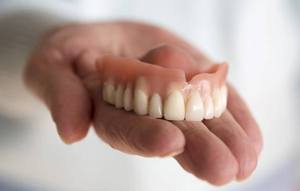
Wood Family Dentistry offers three different types of dentures to provide you with the restoration that best fits your smile.
Partial Dentures
Partial dentures are great for patients who are missing multiple teeth in the same arch of their smile. This replacement allows you to keep your remaining healthy teeth, while replacing the gaps in your grin. We will typically build partial dentures around your remaining teeth, holding them in place with clasps around them for a secure and complete smile.
Full Dentures
Full dentures are the quickest way to restore your smile to its full beauty if you’re missing most or all of your teeth. They rest on your gums using suction to keep them in place, and you can also use denture adhesive to make sure they stay secure. However, they should still be cleaned each night.
Implant-Retained Dentures
If you’re looking for the most stable prosthesis, implant-retained dentures are for you. Using dental implants to anchor your denture in place, this option allows for the strongest biting power and it also preserves the health of your jawbone.
Benefits of Dentures
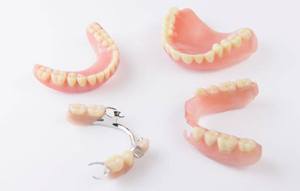
One of the main advantages that dentures have is their ability to replace some or all of your missing teeth. Their versatility allows us to custom-make your denture based on your smile. This completed grin will give you more confidence, higher self-esteem, and the ability to flash your pearly whites for any photo opportunities.
Additionally, dentures are the only replacement that are completely removeable. This allows for easy cleaning and maintenance. They also help fill out your facial appearance, giving you a fuller, more youthful look.
Cost of Dentures

The cost of your dentures will vary based on many factors. Primarily, whether you need a partial, full, or implant-retained denture. Our dentists will give your mouth an in-depth examination to check your oral health and the number and position of your lost teeth. They will then be able to provide a fair estimate and recommendation for your dentures. Contact our office today to get started on your custom-made dentures.
Denture FAQs
Choosing to restore your smile with dentures is a great decision! We want to address any of your questions or concerns before you choose the restoration that’s right for you, so we’ve answered some of the most common questions that we get from our patients below.
How often do I need to replace my dentures?
Unfortunately, dentures aren’t built to last forever and will need to be replaced if they become damaged or too big for your mouth. The average lifespan of these restorations is about seven years. Over that time, the structure of your mouth will change, which is why it’s a good idea to continue visiting our office for checkups to ensure that your dentures still fit properly.
Can I sleep in my dentures?
When you go to sleep, it’s important to give your mouth a rest and take your dentures out. It’s also important to soak your dentures in a special denture solution to make sure they retain their customized shape and stay moist. It’s also important that you don’t wear your dentures for the entire day without taking them out and cleaning them at least once or twice. That way, your gums stay healthy and your dentures stay in good condition.
How can I tell if my dentures need to be adjusted?
Dentures can become easily damaged and sometimes need to be relined over time. Here are some signs that your restorations may need to be adjusted or repaired:
- The acrylic or artificial teeth are cracked or broken.
- You have difficulty chewing with your dentures in and have surpassed the adjustment period.
- You experience jaw soreness, uneven pressure, or general discomfort while wearing your dentures.
- The fit of your dentures has changed over time.
- You notice oral sores beginning to develop due to your dentures.
- Your gums are regularly irritated.
- It becomes harder to speak with your dentures in your mouth.
- You notice stains or an odor.
What factors affect the cost of dentures?
Depending on your unique needs, the cost of your dentures will be different than another patient’s. That’s why it’s important to visit our office for a consultation in order to get an accurate price. Here are some different considerations that can affect the price of restorations:
- The materials used
- The complexity of your treatment
- If you require preparatory procedures, such as a tooth extraction
- The timeline of your treatment
When you visit our office for your consultation, we’ll take images of your mouth and conduct a visual examination. Based on our findings, we’ll develop a treatment plan for you to completely restore the function and look of your grin.

People are living longer than ever, and while regular brushing, flossing, and checkups allow many of us to maintain our natural smiles for a lifetime, sometimes our teeth just can’t keep up. If you’ve lost a tooth (or a few teeth) due to injury or disease, dental implants can rejuvenate both your smile and your oral health.
An implant is a synthetic tooth root in the shape of a post that is surgically placed into the jawbone. The “root” is usually made of titanium: the same material used in many replacement hips and knees, and a metal that is well-suited to pairing with human bone. A replacement tooth is then fixed to the post. The tooth can be either permanently attached or removable. Permanent teeth are more stable and feel more like natural teeth.
The ideal candidate for implants is a non-smoker who has good oral health, including a sufficient amount of bone in the jaw, and healthy gums with no sign of gum disease.
Single or Multiple Implants
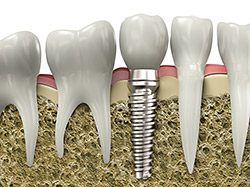
Implants are versatile. If you are only missing one tooth, one implant plus one replacement tooth will do the trick. If you are missing several teeth in a row, a few strategically placed implants can support a permanent bridge (a set of replacement teeth). Similarly, if you have lost all of your teeth, a full bridge or full denture can be permanently fixed in your mouth with a strategic number of implants.
Advantages Over Dentures or Bridges
Conventional bridges and dentures are not fixed to the bone, and can therefore be unstable. This can make it difficult to eat or smile with confidence. Implants not only look more natural, but feel and act more like normal teeth, with a stronger biting force. And because they don’t directly rely on neighboring teeth for support, implants don’t compromise the health of your natural teeth. In fact, bridges are only expected to last seven to ten years, even less with root canals, whereas implants will typically last a lifetime.
Implant Services
SINUS LIFT AUGMENTATION
After the loss of upper back teeth, your sinuses may enlarge in size. Before new implants replace the lost teeth, a sinus lift augmentation or graft relocates the sinus cavity into its original position and replaces the bone that has been lost as a result of the enlarged sinus. This new bone graft typically takes nine to 12 months to heal before the dental implants can be placed into the grafted bone.
AUTOGENOUS BONE GRAFTING
Occasionally, ideal areas where dental implants are to be placed do not have sufficient bone quantity to predictably place the implants. In these cases, it is often necessary to “borrow” bone from another area of your mouth to graft into the deficient area. Often the area of choice is from the chin or in the back of the jaw where your wisdom teeth used to be.
IMPLANT SITE DEVELOPMENT
When a tooth needs to be removed due to infection, it is not uncommon to have bone loss around the infected tooth. In these cases, various types of bone grafting can be done at the same time the tooth is removed to facilitate the placement of a dental implant at a later date.
COMPUTER ENHANCED TREATMENT PLANNING
We have special 3D software that allows us to evaluate your bone quality, bone quantity, and bone location for the best possible placement of your dental implants. This also allows us to work closely and smoothly with your restorative dentist to ensure an ideal result for your dental implants.
IMPLANT MAINTENANCE
Once your dental implant restoration is completed, it is important to keep the area clean and free of infection. Dental implants can accumulate plaque and tartar just as teeth can. Whether you have just one tooth replaced by an implant or several, professional cleanings will be necessary to keep your implants healthy. The time interval for these professional cleanings will be determined by your individual needs.
Post-Treatment Care
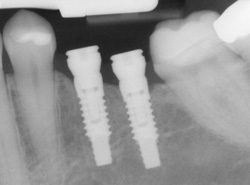
Consider your replacement teeth to be the same as natural teeth. They require the same daily brushing and flossing, and the same amount of regular checkups. Just like your natural teeth, the better you take care of your replacements, the longer they will last.
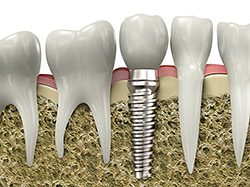
If you are missing teeth, it is crucial to replace them. Without all your teeth, chewing and eating can destabilize your bite and cause you discomfort. When teeth are missing, your mouth can shift and even cause your face to look older. Implants are a great way to replace your missing teeth, and if properly maintained, can last a lifetime!
An implant is a new tooth made of metal and porcelain that looks just like your natural tooth. It’s composed of two main parts: one part is the titanium implant body that takes the place of the missing root, and the second part is the tooth-colored crown that is cemented on top of the implant. With implant treatment, you can smile confidently knowing no one will ever suspect you have a replacement tooth.
In addition to tooth replacement, implants may be used to anchor dentures, especially lower dentures that tend to shift when you talk or chew. For patients with removable partial dentures, implants can replace missing teeth so you have a more natural-looking smile.

Treatment Options
If you’ve been diagnosed with gum disease, there are a variety of treatment options depending on the details of your situation and the severity of the problem. We always start with the least invasive options, which are non-surgical. However, in more serious cases, surgery may be necessary.
Non-Surgical Treatment
The first line of defense against gum disease is a unique type of cleaning called “scaling and root planing.” In this procedure, an ultrasonic cleaning device is used to remove plaque and tartar from your teeth where regular cleaning devices can’t reach: under the gum line, on the tooth, and around the root. Then, the rough surface of the tooth and the root are smoothed out (planed). This provides a healthy, clean surface that makes it easier for the gum tissue to reattach to the tooth.
If you address your gum disease before it becomes severe, scaling and root planing may be the only treatment you need. However, as with any dental procedure, after-care is vital. In order to keep your teeth in good shape and resist future occurrences of gum disease, you must brush and floss daily, eat a healthy diet, avoid tobacco use, and have regular dental checkups. Even after a successful scaling and root planing, if you don’t attend to your teeth properly, it’s quite likely that you’ll develop gum disease again.
Surgical Treatment Options
If the tissue or bone surrounding your teeth is too damaged to be repaired with non-surgical treatment, several surgical procedures are available to prevent severe damage and to restore a healthy smile. We will recommend the procedure that is best suited to the condition of your teeth and gums. Following is a list of common types of periodontal surgery:
- Pocket Depth Reduction
In a healthy mouth, the teeth are firmly surrounded by gum tissue and securely supported by the bones of the jaw. Periodontal disease damages these tissues and bones, leaving open spaces around the teeth that we call pockets. The larger these pockets are, the easier it is for bacteria to collect inside them, leading to more and more damage over time. Eventually the supportive structure degrades to the point that the tooth either falls out or needs to be removed.During pocket reduction procedures (also known as “flap surgery”), we fold back the gum tissue and remove the bacteria hiding underneath, as well as the hardened plaque and tartar that have collected. We may also remove any tissue that is too damaged to survive. We then sew the healthy tissue back into place. Now that the tooth and root are free of bacteria, plaque, and tartar, and the pockets have been reduced, the gums can reattach to the teeth. - Regeneration
When the bone and tissue supporting the teeth have been lost due to severe gum disease, we can restore these areas with a regeneration procedure. During this process, we begin by folding back the gum tissue and removing the bacteria, plaque, and tartar. Depending on your situation, we may then perform a bone graft to stimulate new bone growth, or we may apply a special kind of protein that stimulates tissue growth to repair the areas that have been destroyed by the disease. - Soft-Tissue Graft
A frequent symptom of gum disease is gum recession (also called gingival recession). As the gums recede, more of the roots are revealed. This can make teeth appear longer and can also create sensitivity to hot or cold liquids or food. It also exposes the tooth to increased damage from gum disease, as bacteria, plaque, and tartar attack the surface of the tooth and the root.During a soft-tissue graft, tissue from the top of your mouth or another source is sewed to the gum area, covering the roots and restoring the gum line to its original, healthy location. This procedure can also be performed for cosmetic reasons.
